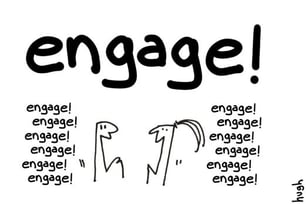Is all content created equal? Our team has done a lot of writing for clients over the past couple decades. When PROSAR first started, we wrote content primarily for printed material: brochures, magazines, posters, ads, reports, even a national literacy program for students. Now, most of our content is used online: website, e-newsletters, banner ads and CTAs, whitepapers, and infographics.

In the early 1990s, when we focused on keywords (a term which we didn’t use at the time), we were looking for words that were evocative and would illicit a desired thought or action. We choose wording that would support the purpose and the brand while providing clarity, comprehension and conciseness. This hasn’t changed (or at least, it shouldn’t have changed), but some additional considerations now play a major role:
- Writing for Search: strategic use of keywords in headings and paragraphs is important to alert Google of the relevance (and value) of your content. This may involve some testing and analysis to determine which keywords resonate with your target audience and which ones offer a probability of success. (Writing seemed difficult enough in the 90s, now it is layered with even more levels of research wordsmithing.)
- Writing for a Multimedia Environment: I’m not sure if more people these days suffer from ADHD, but I do appreciate that we have far more stimuli and choice at our fingertips. So who has the concentration required to read an entire article without clicking, swiping, hovering, or simply glancing aside at the ads, email and texts competing for your attention? We look for snippets and sound-bites (or bytes?) to get the gist and move on to the next bit/byte.
Whether in print or online, each project has its own objectives, audience and tone or style; that does not change. But how your audience will be reading the content does impact how it may be composed. We tend to read more slowly and thoroughly when dealing with print, rather than a faster skimming of the content online. The printed word has a physicality and permanence that seems to give the text some added gravitas. Digital content, on the other hand, seems almost inconsequential; how important can these words be if you can swipe them away with thumb? (Put your thumb away and keep reading; you’re almost finished.)
The reality, is that many of us read far more from a screen than a page these days. So the art of successful writing is now to be as compelling and condensed as possible, while cramming sufficient keywords to encourage good search results.
What are your thoughts on the art of writing online?




 And what does engagement represent?
And what does engagement represent? Overall in Canada,
Overall in Canada,  Another example could be that you have a new product and want to get feedback from your audience. In that case, you might offer a free sample, use a social network like Facebook to create a forum, or ask your audience to spread the word by sharing pics on Instagram.
Another example could be that you have a new product and want to get feedback from your audience. In that case, you might offer a free sample, use a social network like Facebook to create a forum, or ask your audience to spread the word by sharing pics on Instagram.









